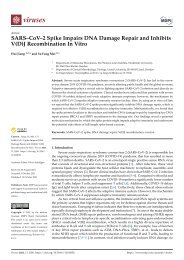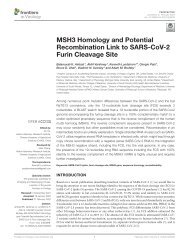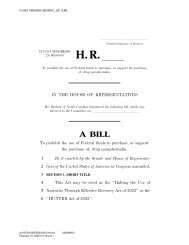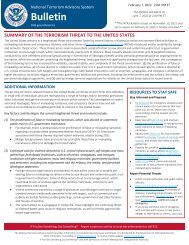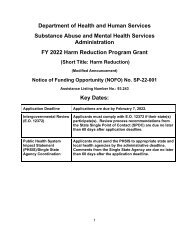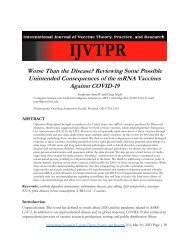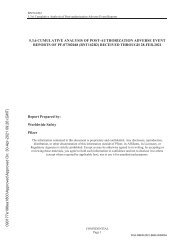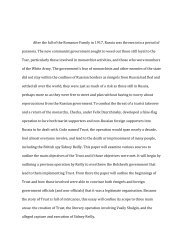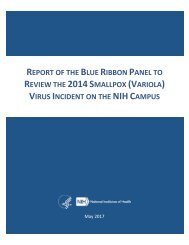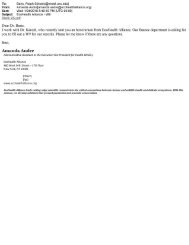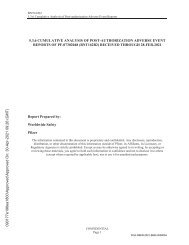A Literature Review and Meta Analysis of the Effects of Lockdowns on COVID 19 Mortality
Create successful ePaper yourself
Turn your PDF publications into a flip-book with our unique Google optimized e-Paper software.
1. Study (Author &<br />
title)<br />
2.<br />
Measure<br />
3. Descripti<strong>on</strong> 4. Results 5. Comments<br />
B<strong>on</strong>ardi et al. (2020);<br />
"Fast <str<strong>on</strong>g>and</str<strong>on</strong>g> local: How did<br />
lockdown policies affect<br />
<str<strong>on</strong>g>the</str<strong>on</strong>g> spread <str<strong>on</strong>g>and</str<strong>on</strong>g> severity <str<strong>on</strong>g>of</str<strong>on</strong>g><br />
<str<strong>on</strong>g>the</str<strong>on</strong>g> covid-<strong>19</strong>"<br />
B<strong>on</strong>gaerts et al. (2021);<br />
"Closed for business: The<br />
mortality impact <str<strong>on</strong>g>of</str<strong>on</strong>g><br />
business closures during<br />
<str<strong>on</strong>g>the</str<strong>on</strong>g> Covid-<strong>19</strong> p<str<strong>on</strong>g>and</str<strong>on</strong>g>emic"<br />
Chaudhry et al. (2020); "A<br />
country level analysis<br />
measuring <str<strong>on</strong>g>the</str<strong>on</strong>g> impact <str<strong>on</strong>g>of</str<strong>on</strong>g><br />
government acti<strong>on</strong>s,<br />
country preparedness <str<strong>on</strong>g>and</str<strong>on</strong>g><br />
socioec<strong>on</strong>omic factors <strong>on</strong><br />
<strong>COVID</strong>-<strong>19</strong> mortality <str<strong>on</strong>g>and</str<strong>on</strong>g><br />
related health outcomes"<br />
Chernozhukov et al.<br />
(2021); "Causal impact <str<strong>on</strong>g>of</str<strong>on</strong>g><br />
masks, policies, behavior<br />
<strong>on</strong> early covid-<strong>19</strong><br />
p<str<strong>on</strong>g>and</str<strong>on</strong>g>emic in <str<strong>on</strong>g>the</str<strong>on</strong>g> U.S."<br />
Growth<br />
rates<br />
<strong>COVID</strong>-<br />
<strong>19</strong><br />
mortality<br />
<strong>COVID</strong>-<br />
<strong>19</strong><br />
mortality<br />
Growth<br />
rates<br />
events, closing schools, lockdowns <str<strong>on</strong>g>of</str<strong>on</strong>g><br />
workplaces, interrupti<strong>on</strong> <str<strong>on</strong>g>of</str<strong>on</strong>g> public<br />
transportati<strong>on</strong> services, <str<strong>on</strong>g>and</str<strong>on</strong>g> internati<strong>on</strong>al<br />
border closures. They address <str<strong>on</strong>g>the</str<strong>on</strong>g><br />
possible endogeneity <str<strong>on</strong>g>of</str<strong>on</strong>g> <str<strong>on</strong>g>the</str<strong>on</strong>g> NPIs by using<br />
instrumental variables.<br />
Use NPI data scraped from news<br />
headlines from LexisNexis <str<strong>on</strong>g>and</str<strong>on</strong>g> death data<br />
from Johns Hopkins University up to April<br />
1st 2020 in a panel structure with 184<br />
countries. C<strong>on</strong>trols for country fixed<br />
effects, day fixed effects <str<strong>on</strong>g>and</str<strong>on</strong>g> withincountry<br />
evoluti<strong>on</strong> <str<strong>on</strong>g>of</str<strong>on</strong>g> <str<strong>on</strong>g>the</str<strong>on</strong>g> disease.<br />
Uses variati<strong>on</strong> in exposure to closed<br />
sectors (e.g. tourism) in municipalities<br />
within Italy to estimate <str<strong>on</strong>g>the</str<strong>on</strong>g> effect <str<strong>on</strong>g>of</str<strong>on</strong>g><br />
business closures. Assuming that<br />
municipalities with different exposures to<br />
closed sectors are not inherently<br />
different, <str<strong>on</strong>g>the</str<strong>on</strong>g>y find that municipalities<br />
with higher exposure to closed sectors<br />
experienced subsequently lower mortality<br />
rates.<br />
Uses informati<strong>on</strong> <strong>on</strong> <strong>COVID</strong>-<strong>19</strong> related<br />
nati<strong>on</strong>al policies <str<strong>on</strong>g>and</str<strong>on</strong>g> health outcomes<br />
from <str<strong>on</strong>g>the</str<strong>on</strong>g> top 50 countries ranked by<br />
number <str<strong>on</strong>g>of</str<strong>on</strong>g> cases. Finds no significant<br />
effect <str<strong>on</strong>g>of</str<strong>on</strong>g> any NPI <strong>on</strong> <str<strong>on</strong>g>the</str<strong>on</strong>g> number <str<strong>on</strong>g>of</str<strong>on</strong>g><br />
<strong>COVID</strong>-<strong>19</strong>-deaths.<br />
Uses <strong>COVID</strong>-deaths from <str<strong>on</strong>g>the</str<strong>on</strong>g> New York<br />
Times <str<strong>on</strong>g>and</str<strong>on</strong>g> Johns Hopkins <str<strong>on</strong>g>and</str<strong>on</strong>g> data for<br />
U.S. States from Raifman et al. (2020) to<br />
estimate <str<strong>on</strong>g>the</str<strong>on</strong>g> effect <str<strong>on</strong>g>of</str<strong>on</strong>g> SIPO, closed<br />
n<strong>on</strong>essential businesses, closed K-12<br />
schools, closed restaurants except<br />
takeout, closed movie <str<strong>on</strong>g>the</str<strong>on</strong>g>aters, <str<strong>on</strong>g>and</str<strong>on</strong>g> face<br />
mask m<str<strong>on</strong>g>and</str<strong>on</strong>g>ates for employees in public<br />
facing businesses.<br />
insignificant. On <str<strong>on</strong>g>the</str<strong>on</strong>g><br />
c<strong>on</strong>trary, estimates<br />
using <str<strong>on</strong>g>the</str<strong>on</strong>g> instrumental<br />
variable approach<br />
indicate that NPIs are<br />
effective in reducing<br />
<str<strong>on</strong>g>the</str<strong>on</strong>g> growth rate in <str<strong>on</strong>g>the</str<strong>on</strong>g><br />
daily number <str<strong>on</strong>g>of</str<strong>on</strong>g> deaths<br />
14 days later.<br />
Find that certain<br />
interventi<strong>on</strong>s (SIPO,<br />
regi<strong>on</strong>al lockdown <str<strong>on</strong>g>and</str<strong>on</strong>g><br />
partial lockdown) work<br />
(in developed<br />
countries), but that<br />
stricter interventi<strong>on</strong>s<br />
(SIPO) do not have a<br />
larger effect than less<br />
strict interventi<strong>on</strong>s (e.g.<br />
restricti<strong>on</strong>s <strong>on</strong><br />
ga<str<strong>on</strong>g>the</str<strong>on</strong>g>rings). Find no<br />
effect <str<strong>on</strong>g>of</str<strong>on</strong>g> border<br />
closures.<br />
Business shutdown<br />
saved 9,439 Italian lives<br />
by April 13th 2020. This<br />
corresp<strong>on</strong>ds to a<br />
reducti<strong>on</strong> <str<strong>on</strong>g>of</str<strong>on</strong>g> deaths by<br />
32%, as <str<strong>on</strong>g>the</str<strong>on</strong>g>re were<br />
20,465 <strong>COVID</strong>-<strong>19</strong>-<br />
deaths in Italy by mid<br />
April 2020.<br />
Finds no significant<br />
effect <strong>on</strong> mortality <str<strong>on</strong>g>of</str<strong>on</strong>g><br />
any <str<strong>on</strong>g>of</str<strong>on</strong>g> <str<strong>on</strong>g>the</str<strong>on</strong>g> analyzed<br />
interventi<strong>on</strong>s (partial<br />
border closure,<br />
complete border<br />
closure, partial<br />
lockdown (physical<br />
distancing measures<br />
<strong>on</strong>ly), complete<br />
lockdown (enhanced<br />
c<strong>on</strong>tainment measures<br />
including suspensi<strong>on</strong> <str<strong>on</strong>g>of</str<strong>on</strong>g><br />
all n<strong>on</strong>-essential<br />
services), <str<strong>on</strong>g>and</str<strong>on</strong>g> curfews).<br />
Finds that m<str<strong>on</strong>g>and</str<strong>on</strong>g>atory<br />
masks for employees<br />
<str<strong>on</strong>g>and</str<strong>on</strong>g> closing K-12<br />
schools reduces deaths.<br />
SIPO <str<strong>on</strong>g>and</str<strong>on</strong>g> closing<br />
business (average <str<strong>on</strong>g>of</str<strong>on</strong>g><br />
closed businesses,<br />
restaurants <str<strong>on</strong>g>and</str<strong>on</strong>g> movie<br />
<str<strong>on</strong>g>the</str<strong>on</strong>g>aters) has no<br />
statistically significant<br />
effect. The effect <str<strong>on</strong>g>of</str<strong>on</strong>g><br />
school closures is highly<br />
sensitive to <str<strong>on</strong>g>the</str<strong>on</strong>g><br />
multicollinearity with each run capturing <str<strong>on</strong>g>the</str<strong>on</strong>g><br />
same underlying effect. Indeed, <str<strong>on</strong>g>the</str<strong>on</strong>g> size <str<strong>on</strong>g>and</str<strong>on</strong>g><br />
st<str<strong>on</strong>g>and</str<strong>on</strong>g>ard errors <str<strong>on</strong>g>of</str<strong>on</strong>g> <str<strong>on</strong>g>the</str<strong>on</strong>g> estimates are worryingly<br />
similar. Looks at <str<strong>on</strong>g>the</str<strong>on</strong>g> effect 14 days after NPIs<br />
are implemented which is a fairly short lag given<br />
<str<strong>on</strong>g>the</str<strong>on</strong>g> time between infecti<strong>on</strong> <str<strong>on</strong>g>and</str<strong>on</strong>g> deaths is 2-3<br />
weeks, cf. e.g. Flaxman et al. (2020), which<br />
according to Bjørnskov (2020) appears to be <str<strong>on</strong>g>the</str<strong>on</strong>g><br />
minimum typical time from infecti<strong>on</strong> to death).<br />
Find a positive (more deaths) effect <strong>on</strong> day 1<br />
after lockdown which may indicate that <str<strong>on</strong>g>the</str<strong>on</strong>g>ir<br />
results are driven by o<str<strong>on</strong>g>the</str<strong>on</strong>g>r factors (omitted<br />
variables). We rely <strong>on</strong> <str<strong>on</strong>g>the</str<strong>on</strong>g>ir publicly available<br />
versi<strong>on</strong> submitted to CEPR Covid Ec<strong>on</strong>omics,<br />
but estimates <strong>on</strong> <str<strong>on</strong>g>the</str<strong>on</strong>g> effect <str<strong>on</strong>g>of</str<strong>on</strong>g> deaths can be<br />
found in Supplementary material, which is<br />
available in an updated versi<strong>on</strong> hosted <strong>on</strong> <str<strong>on</strong>g>the</str<strong>on</strong>g><br />
Danish Broadcasting Corporati<strong>on</strong>'s webpage:<br />
https://www.dr.dk/static/documents/2021/03/<br />
04/managing_p<str<strong>on</strong>g>and</str<strong>on</strong>g>emics_e3911c11.pdf<br />
They (implicitly) assume that municipalities with<br />
different exposures to closed sectors are not<br />
inherently different. This assumpti<strong>on</strong> could be<br />
problematic, as more touristed municipalities<br />
can be very different from e.g. more<br />
industrialized municipalities.<br />
States that ”our regressi<strong>on</strong> specificati<strong>on</strong> for case<br />
<str<strong>on</strong>g>and</str<strong>on</strong>g> death growths is explicitly guided by a SIR<br />
model although our causal approach does not<br />
hinge <strong>on</strong> <str<strong>on</strong>g>the</str<strong>on</strong>g> validity <str<strong>on</strong>g>of</str<strong>on</strong>g> a SIR model.” We are<br />
uncertain if this means that data are managed to<br />
fit an SIR-model (<str<strong>on</strong>g>and</str<strong>on</strong>g> thus should fail our<br />
eligibility criteria).<br />
17




